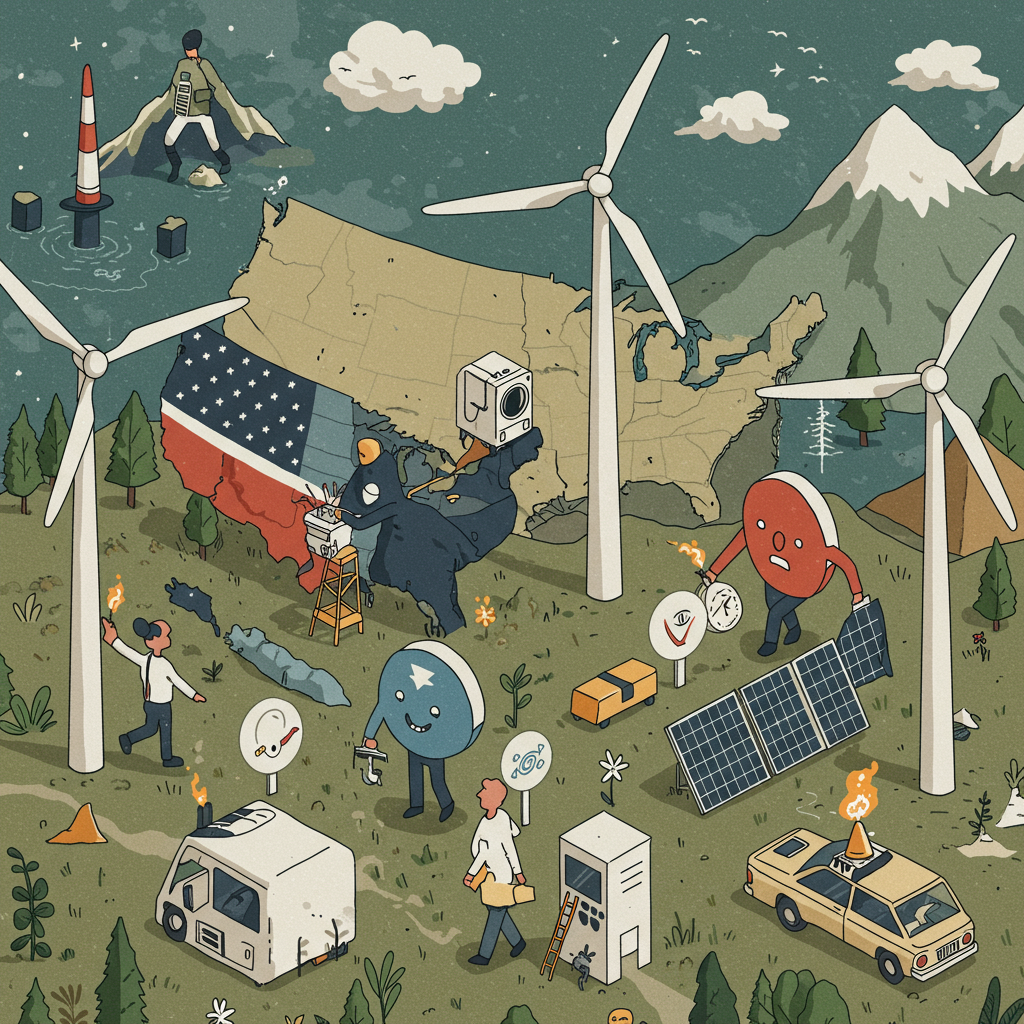A proposed policy shift aiming to bolster fossil fuels while scaling back support for renewables is drawing sharp criticism for potentially undermining a critical growth sector of the US economy: clean energy. This legislative package, recently moving through Congress, represents a significant departure from recent efforts to accelerate the transition to cleaner power sources. Experts warn these changes could hobble job growth, increase energy costs for consumers, and cause the United States to fall behind global competitors in a rapidly expanding industry.
A Pivotal Shift in US Energy Policy
At the heart of the debate is a comprehensive bill that includes provisions specifically targeting the energy sector. Far from advancing renewable technologies, the legislation seeks to reverse key policies enacted to support clean energy deployment. Critics point out that this represents a direct challenge to the momentum built by measures like the 2022 Inflation Reduction Act, which significantly boosted investments in the energy transition.
Rolling Back Incentives, Boosting Fossil Fuels
The bill proposes accelerating the phaseout of tax credits crucial for wind and solar power projects. Additionally, it eliminates the $7,500 federal tax credit available for the purchase of new electric vehicles, a key incentive for consumer adoption. In a move seen as favoring traditional energy sources, the legislation introduces a new tax credit specifically for coal, an energy source that has seen a decades-long decline in employment and market share. These provisions align with stated policy goals of prioritizing fossil fuels and reducing support for renewables.
Economic Stakes: Jobs, Growth, and Global Competitiveness
The potential impacts of this policy shift extend far beyond environmental concerns, touching upon the economic health and global standing of the United States. The clean energy sector currently employs nearly twice as many Americans as the fossil fuel industry, and it has been a significant source of new job creation. Curtailing investment and incentives risks stalling this growth trajectory.
The US holds a history of pioneering energy technologies, from the first solar cell to early leadership in electric vehicles and lithium-ion batteries. However, that lead has often been ceded to other nations. Today, countries like China dominate the manufacturing of solar cells and batteries, and a Chinese company has surpassed Tesla in EV production. Globally, investment in clean energy is soaring, projected to reach $2.2 trillion this year alone, with renewables on track to become the world’s largest power source. By stepping back from clean energy support, the US risks losing its foothold in this massive, expanding global market, particularly as developing countries industrialize and developed nations pursue decarbonization goals.
Meeting Soaring Energy Demand: The Grid Challenge
Adding complexity to the situation is the current state of the US power grid. For the first time in decades, the nation is experiencing substantial load growth. This surge in demand is driven in part by the energy-intensive needs of the tech industry, particularly massive data centers, and growing advanced manufacturing. Meeting this increased demand quickly and affordably is paramount.
Clean energy sources like solar, wind, and battery storage are currently the fastest and often the cheapest options for adding new power capacity to the grid. Their deployment times are relatively short, and technology costs have fallen dramatically. In contrast, building new fossil fuel power plants, such as those powered by natural gas, can take years due to complex permitting, siting, and construction processes. While the US is a major oil and gas producer, prices for these commodities are subject to international market fluctuations, adding price volatility. Executives and analysts highlight that while renewables and storage are “ready now” to meet demand, large-scale gas plant additions may not be feasible for several years.
Deployment Speed vs. Cost Certainty
Even with potential policy headwinds, the fundamental economic case for clean energy remains strong. Falling costs, coupled with existing project pipelines and state-level initiatives, mean solar, wind, and battery storage projects are still proceeding, albeit potentially at a slower pace. This contrasts with the longer lead times and potentially higher construction costs now associated with new fossil fuel plants. The choice of energy source significantly impacts how quickly and affordably the nation can power its future growth.
Broader Impacts: Supply Chains, Innovation, and Costs
The proposed changes extend beyond just tax credits. They could also slow efforts to build a robust domestic supply chain for clean energy technologies, including sourcing critical minerals like lithium and establishing battery manufacturing facilities. Furthermore, the legislation does little to address persistent bottlenecks in connecting new power plants to the grid, which can add years to project timelines for all energy types. Reducing investment in energy research and development risks stifling the innovation needed for future breakthroughs. Ironically, tariffs included in the broader legislative package could even raise operating costs for the very fossil fuel industries the bill seeks to support.
Analysis suggests these combined factors could lead to tangible costs for consumers and the economy. Estimates indicate the policy could reduce the amount of energy added to the grid compared to current projections, potentially increasing average household electricity bills by $130 per year. Furthermore, analyses project a loss of nearly a trillion dollars in economic productivity and a cost of 760,000 jobs by 2030 under this policy framework.
Navigating Policy Headwinds: Market Reality vs. Political Goals
Despite the proposed rollbacks and political opposition, the US clean energy industry continues to demonstrate resilience, driven by strong market demand, falling costs, and existing policy support like the Inflation Reduction Act and state-level mandates. Large corporations continue to drive demand through renewable energy purchase agreements, and investors see renewables as a favorable option. Some voices within the Republican party even advocate for preserving clean energy tax credits, recognizing the risk of an energy crisis and higher power bills if new generation is hindered.
However, the policy uncertainty created by the legislation and potential future regulatory actions poses a significant threat. Attempts to limit agency authority on renewable permits, halt offshore wind leases, or repeal existing incentives could slow development and create nervousness in the market. Reports indicate some companies have already paused or cancelled US clean energy investments citing the evolving policy environment. While repealing major legislative packages like the IRA outright would require Congressional action, which could be challenging given clean energy investments in various states, a future administration could utilize regulatory changes and potentially find support in a judiciary increasingly skeptical of administrative power to slow down or weaken implementation.
Regulatory Challenges and Judicial Landscape
A potential avenue for implementing an agenda prioritizing fossil fuels lies in regulatory changes. Streamlining permitting for drilling and pipelines, while limiting environmental reviews, could boost fossil fuel deployment. Conversely, regulatory hurdles could be increased for renewable projects. The recent judicial landscape, with decisions emphasizing the “major questions doctrine” and limiting agency deference, could make it easier for courts to challenge federal regulations supporting clean energy, potentially clearing the path for regulatory rollbacks.
The Path Forward: Choices and Consequences
The debate over US energy policy involves high stakes for the economy, energy security, job market, and the global energy transition. While the market-driven case for clean energy deployment remains compelling due to its speed, cost-effectiveness, and lower emissions profile, proposed policies represent a deliberate obstacle course. The decisions made now about federal support and regulatory direction will profoundly impact the nation’s ability to meet rising energy demand, maintain competitiveness in a key global industry, and control energy costs for American households and businesses for years to come.
Frequently Asked Questions
What specific changes would the proposed bill make to clean energy incentives?
The proposed legislation would roll back investments from the 2022 Inflation Reduction Act. It specifically accelerates the phaseout of tax credits for wind and solar power, eliminates the $7,500 tax credit for purchasing new electric vehicles, and creates a new tax credit specifically for coal. These changes aim to shift federal support away from renewable sources and towards fossil fuels.
How could rolling back clean energy support impact energy costs and jobs?
Experts project significant negative economic consequences. Reducing the amount of new clean energy added to the grid could increase average household electricity prices by about $130 per year. Estimates also suggest a loss of nearly a trillion dollars in economic productivity by 2030 and the potential elimination of 760,000 jobs, largely in the clean energy sector, which currently employs significantly more Americans than fossil fuels.
Why is the US clean energy sector growing now despite potential policy opposition?
Despite proposed policy shifts, the US clean energy sector is experiencing strong growth primarily due to surging electricity demand (driven by data centers and manufacturing), falling technology costs for solar, wind, and batteries, and support from existing policies like the Inflation Reduction Act and state mandates. Market forces, corporate purchasing agreements, and investor confidence in renewables as a cost-effective, rapidly deployable option are currently outweighing some political headwinds.



